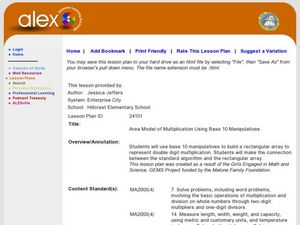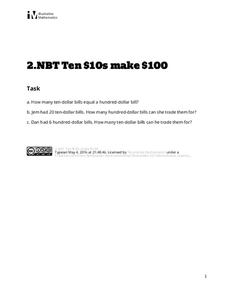Curated OER
Ordering Sets of Two
Place value is important as scholars begin ordering larger number based on their values. They order seven sets of numbers, ranging from three digits to seven digits. Then, they complete a word problem by examining four town populations...
K-5 Math Teaching Resources
Base Ten Cards (tens and ones)
Strengthen your class's understanding of place value with this series of base-ten flash cards. Including illustrations representing a variety of numbers from 13 to 94, this resource can be used in many different ways to build the numbers...
Curated OER
Number Base Clocks
Young scholars investigate place value in base ten. In this number sense instructional activity, students participate in an online instructional activity at www.shodor.org/interactivate/activities/NumberBaseClocks and demonstrate how to...
Curated OER
Area Model of Multiplication Using Base 10 Manipulatives
Explore two-digit multiplication with your class as they work in groups to build models of two-digit multiplication using base 10 manipulatives. They construct rectangles replacing standard numbers with equivalent place values using the...
Royal Society of Chemistry
Acids and Bases—Microscale Chemistry
Here's proof that small-scale labs lead to big-time learning. Introduce acid-base interactions to middle school scientists through a microscale chemistry lab. Pupils combine a variety of solutions and use indicators to obtain approximate...
Curated OER
Walk Two Moons: The Lunatic Mystery Case Book
Here’s the meatball in the bowl of spaghetti. Readers build a Lunatic Mystery Case Book, collecting evidence to support their prediction about the identity of the lunatic in Walk Two Moons, Sharon Creech’s Newbery Medal winning novel....
Illustrative Mathematics
Equality Number Sentences
Understanding the concept of equality is fundamental to the success of young mathematicians. To explore this basic idea, children compare the dots arranged in pairs of rectangles in order to determine whether or not they contain an equal...
Anti-Defamation League
Identity-Based Bullying
What is identity? What is bullying? What is identity-based bullying? After discussing these questions as a class, pupils engage in partner discussions before participating in a small group activity to act out bullying scenarios. Then,...
Curated OER
Subtraction with Base 10 Models
Learning how to regroup can be a difficult concept to learn, as well as teach. This PowerPoint does an excellent job at visualizing the process with step-by-step guidelines and base ten animations. There are multiple examples for...
Curated OER
Acids, Bases, and Indicators
Chemistry or physical science fledglings get comfortable identifying acids and bases with a variety of pH indicators. They discover that different indicator solutions have different ranges, practice testing soil acidity, and use antacids...
Code.org
Number Systems
Generating a system of shapes. Groups work together to create a number system using three different shapes as symbols. The groups should come up with the rules that generate all the possible permutations of the three shapes.
Illustrative Mathematics
Ten $10s Make $100
If ten $10s make $100, then how much money do twenty $10s make? Young bankers find the number of bills required to make base ten amounts in three different word problems.
Education Development Center
Micro-Geography of the Number Line
Young mathematicians dive into the number line to discover decimals and how the numbers infinitely get smaller in between. They click the zoom button a few times and learn that the number line doesn't just stop at integers. Includes a...
Institute for Teaching through Technology and Innovative Practices
The Right Number of Elephants
How can you tell if a number of items is reasonable? Combine math and language arts with a fun lesson based on Jeff Shepard's The Right Number of Elephants. After reading the book, kids discuss amounts of other items and create minibooks...
Curated OER
Give Me Five!
Students become familiar with their five senses and how their experiences would change without them. In this observations instructional activity, students observe using their five senses in a garden. Students illustrate what they've...
Curated OER
How to Implement Project Based Learning to Engage Students
Can a math teacher employ project-based learning? Learn how one great math teacher uses PBL to design math projects that provide learners with a more challenging and holistic learning experience. A wonderful article, that includes three...
Curated OER
Project-Based Learning & Leading Through the 16 Habits of Mind
Blending Costa & Kallick's 16 Habits of Mind, personality type, and project-based learning in your classroom.
Curated OER
Counting with Base - Ten Models
Help your kids develop strategies for counting. In this base-ten lesson, learners use matching cards, base 10 blocks, and dry erase markers and boards to examine the base 10 counting system.
Curated OER
Chapter 14 Review, Section 3: Acids and Bases
Aside from a mention of a textbook page, this chemistry assignment is a suitable review of acids and bases. It begins by addressing conjugate pairs and acid base reactions. Neutralization and amphoteric properties are also dealt with....
Curated OER
Smaller Than One
Students examine how to convert fractions into decimals and percents. They work with base ten blocks and a worksheet to color in parts of 100 and renaming the parts as decimals and fractions.
Beacon Learning Center
Ten Pins
Multiplying with multiples of 10, 100, and 1,000 provides an opportunity to discuss patterns that arise with zeros. The class uses these patterns to solve problems. Then they rotate through three work stations, including a computer-based...
Curated OER
Strong Acids and Bases
A straight-forward exercise awaits your chemistry charges. Two pages provide plenty of room for them to calculate the pH of five solutions, determine the number of hydrogen and hydroxide ions, and solve problems dealing with solutions....
Curated OER
Powers of Ten
In this powers of ten worksheet, 5th graders multiply and divide decimals by multiples of ten. They mentally solve simple problems containing powers of ten. This two-page worksheet contains 10 problems.
Curated OER
Number Patterns in Everyday Life
Examine scenarios involving number patterns. Learners complete a series of activities, including working with Pascal's triangle ando completing chart activities based on different pricing for pizza toppings. An included extension has...

























